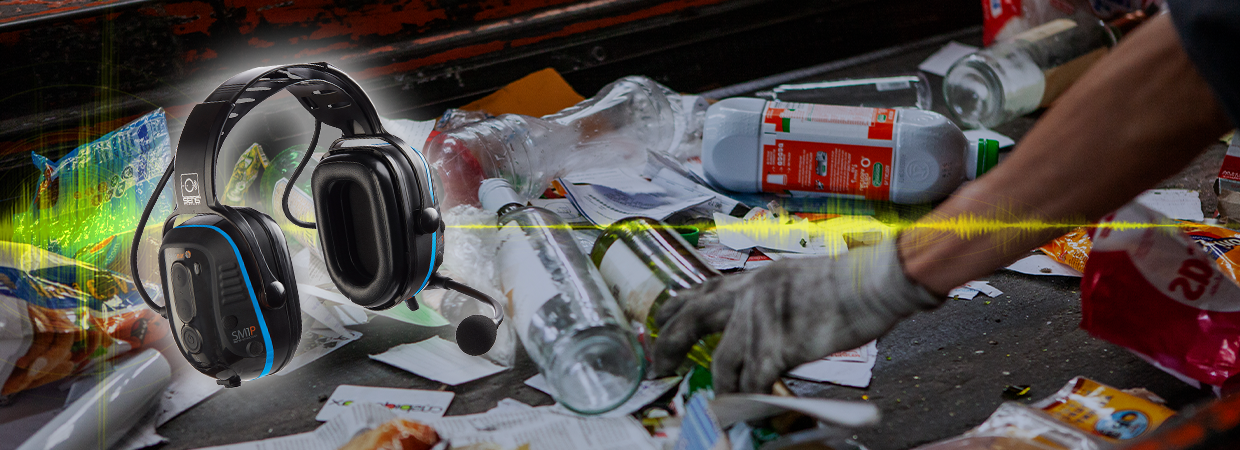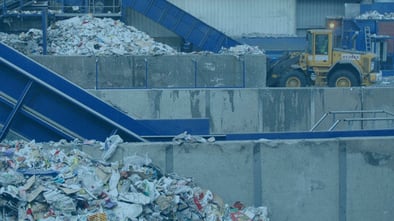- Home
- Blog
- High-Noise Workplace Safety
- Improving Safety and Communication in Recycling & Solid Waste Industry

Improving Safety and Communication in Recycling & Solid Waste Industry
 Workers employed in the recycling and solid waste industry face many hazards that can lead to serious injury, illness, or death because of their daily exposure to harmful substances and the use of hazardous machinery.
Workers employed in the recycling and solid waste industry face many hazards that can lead to serious injury, illness, or death because of their daily exposure to harmful substances and the use of hazardous machinery.
OSHA has issued a notice to renew the Local Emphasis Program (LEP) to reduce the incidence of serious health and physical injury or death from hazards associated with the assembly, breaking up, separating, sorting, processing, handling, and wholesale distribution of solid waste and recyclable materials in Industry establishments.
What are the Risks?
A major potential risk for workers is hearing damage from overexposure to industrial noise. A recent study of refuse collection and recycling of glass bottles had some of the highest noise levels ranging from 108-131 dB(A), with personal noise exposure levels of about 100 dB(A) on the high end of the results. Another study showed when glass hits glass on refuge pickup from plastic wheeled bins being emptied, extremely high noise levels are emitted. Peak levels above 140 dB(A) were measured, making it possible for workers during a typical shift to frequently be exposed to peak noise levels over 137 dB(A).
Beyond the problem of high noise exposure, workers in recycling and solid waste environments also face issues with personal safety from large equipment and miscommunication during emergency situations. What kind of solution exists to solve all these factors?
How Does Sensear Improve Safety and Communication?
When working in high-noise environments, there are many contributing factors to the unsafety of a worker. Sensear drives a new approach to occupational hearing conservation by combining the most innovative communication systems with the very best hearing protection technologies, to ensure that users can hear speech and stay protected in high-noise workplace environments.
1. Hearing Protection
All Sensear devices have passed the required hearing protection industry certifications to ensure effective communication with hearing protection. When it comes to noise, there are three main types of noise frequencies that Sensear's SENS® Technology analyzes: broadband noise, impulse noise, and tonal noise. For all these types of noises, SENS® will recognize each frequency and limit their maximum output to 82 dB(A) in noise up to 105 dB(A), and for the Extreme Noise Headsets, up to 120 dB(A).
Broadband noise (also called wideband noise) is "noise whose sound energy is distributed over a wide section of the audible range" (Acoustic Glossary: Sound and Vibration Terms and Definitions). Broadband noise can be anything from speech frequencies to loud machinery frequencies, where the noise has random or broad patterns.
Impulse noise is noise characterized by sharp, brief increases in dB volume. High-decibel impulse noises can cause temporary or permanent hearing loss, as they are constant and deafening. Examples of impulse noises include jackhammers or gunfire.
Tonal noise (otherwise known as discrete frequency noise) is flat noise that occurs at a single frequency. Tonal noises include blades, fans, motors, or other moving parts that rotate or vibrate.
2. Personal Safety & Situational Awareness
Sensear delivers 360° binaural situational awareness with SENS®, allowing users to stay alert for critical noises such as large moving equipment, alarms, forklifts, or other hazards. By providing hearing protection while still allowing directional alertness, SENS® provides 360° situational awareness to ensure that users have a complete awareness of what is happening around them. Whether it be waste-crushing machinery, large vehicles moving around, or emergency alarms going off, solid waste employees will always be aware of everything.
3. High-Noise Communication Solution
Sensear delivers a total high-noise communication solution by ensuring users can communicate face-to-face, at short and long distances via a two-way radio, Bluetooth® wireless technology mobile device, and/or other communication system. In particular, Sensear's headsets and earplugs prioritize two-way communication over all other frequencies, even with the volume limiter on. This allows users to always be alerted to emergency broadcasts over their two-way radio channels. This is an added improvement in safety and communication for workers in recycling and solid waste workplaces.
High Noise Communication and Hearing Protection Solutions for Recycling and Solid Waste Industry
Sensear is a global leader in developing and manufacturing a wide variety of best-in-class Digital Communication and Active Listening Headsets and Earplugs for use in high-noise and hazardous environments. There can be several clothing restrictions in this industry, such as jackets, hats, helmets, gloves, or respirators. However, Sensear offers 3 different styles of headsets to fit your needs (headband, behind-the-neck, or helmet-mounted), as well as extreme noise earplugs for use with respirators or other facial restrictors.
SENS® simultaneously enhances speech and suppresses background noise so that users can communicate face-to-face, protect their hearing, and still maintain 360° awareness of their surroundings in noisy environments such as solid waste and recycling industrial workplaces.
Workers can have seamless face-to-face conversations with workers in the work area without screaming and can communicate clearly on their two-way radios or Bluetooth® wireless technology enabled devices, all while protecting their hearing. Sensear is the perfect solution for workers in the recycling and solid waste industry.









